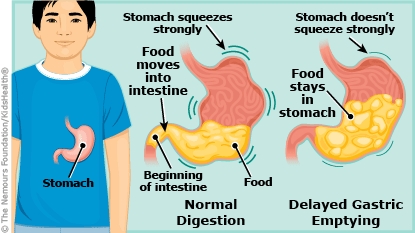Delayed Gastric Emptying: How to Care for Your Child
In delayed gastric emptying, food stays in the stomach longer than it should. Medicines and lifestyle changes can help your child feel better.


In normal digestion, the stomach muscles contract (squeeze) to break food down and move it into the small intestine. The stomach usually moves about 90% of eaten food into the small intestine within 4 hours. In kids with delayed gastric emptying or gastroparesis, the stomach muscles don't contract strongly and food stays in the stomach longer. A child may feel full after eating only a little bit of food; lose weight; or have bloating, nausea, or vomiting.
Delayed gastric emptying can happen on its own, after an infection, or as a side effect of certain medications. It is common in people with diabetes (a disease that affects how the body uses a sugar called glucose) and some other health conditions.
The health care provider talked to you and your child and did a physical exam. The health care provider may have looked in the stomach with a tiny light and camera (endoscope). Studies to see how quickly food moves through the stomach might have been done. These studies require that your child eat a special food. Then health care providers can take pictures of the inside of the body as the food moves through the stomach and into the intestines. Blood tests are sometimes done to help health care providers understand what is causing the symptoms.
Lifestyle changes and medicine can help with symptoms. If your child has another medical condition, such as diabetes, managing it also can help improve your child's digestion.

-
Give your child any prescribed medicine as directed by the health care provider.
-
If your health care provider recommended vitamin or mineral supplements, give them to your child as directed.
-
Follow your health care provider's suggestions for your child's diet. These may include:
-
Offer your child at least six small meals throughout the day, instead of three large ones.
-
Limit fried foods and other high-fat foods.
-
Offer smoothies or cooked fruits and vegetables instead of raw fruits and vegetables, which can be hard to digest.
-
Cut down on high-fiber foods, which can make symptoms worse.
-
Offer your child soft and easily digested foods, such as soups, baked or mashed potatoes, rice, noodles, and baked chicken or fish.
-
Avoid sodas and other carbonated drinks.
-
Your child should avoid lying down for 2 hours after eating. Sitting, standing, or going for a walk may help with digestion.

-
Your health care provider may refer your child to a dietitian, who can help identify healthy foods that are easier for your child to digest.
-
Make any follow-up appointments as directed.

Your child:

Your child: